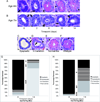The CDK4/6 inhibitor PD0332991 reverses epithelial dysplasia associated with abnormal activation of the cyclin-CDK-Rb pathway
- PMID: 22508966
- PMCID: PMC3368087
- DOI: 10.1158/1940-6207.CAPR-11-0532-T
The CDK4/6 inhibitor PD0332991 reverses epithelial dysplasia associated with abnormal activation of the cyclin-CDK-Rb pathway
Abstract
Loss of normal growth control is a hallmark of cancer progression. Therefore, understanding the early mechanisms of normal growth regulation and the changes that occur during preneoplasia may provide insights of both diagnostic and therapeutic importance. Models of dysplasia that help elucidate the mechanisms responsible for disease progression are useful in highlighting potential targets for prevention. An important strategy in cancer prevention treatment programs is to reduce hyperplasia and dysplasia. This study identified abnormal upregulation of cell cycle-related proteins cyclin D1, cyclin-dependent kinase (CDK)4, CDK6, and phosphorylated retinoblastoma protein (pRb) as mechanisms responsible for maintenance of hyperplasia and dysplasia following downregulation of the initiating viral oncoprotein Simian virus 40 (SV40) T antigen. Significantly, p53 was not required for successful reversal of hyperplasia and dysplasia. Ligand-induced activation of retinoid X receptor and PPARγ agonists attenuated cyclin D1 and CDK6 but not CDK4 or phosphorylated pRb upregulation with limited reversal of hyperplasia and dysplasia. PD0332991, an orally available CDK4/6 inhibitor, was able to prevent upregulation of cyclin D1 and CDK6 as well as CDK4 and phosphorylated pRb and this correlated with a more profound reversal of hyperplasia and dysplasia. In summary, the study distinguished CDK4 and phosphorylated pRb as targets for chemoprevention regimens targeting reversal of hyperplasia and dysplasia.
©2012 AACR.
Figures






Similar articles
-
The CDK4/CDK6 inhibitor PD0332991 paradoxically stabilizes activated cyclin D3-CDK4/6 complexes.Cell Cycle. 2014;13(18):2879-88. doi: 10.4161/15384101.2014.946841. Cell Cycle. 2014. PMID: 25486476 Free PMC article.
-
p16-Cdk4-Rb axis controls sensitivity to a cyclin-dependent kinase inhibitor PD0332991 in glioblastoma xenograft cells.Neuro Oncol. 2012 Jul;14(7):870-81. doi: 10.1093/neuonc/nos114. Epub 2012 Jun 18. Neuro Oncol. 2012. PMID: 22711607 Free PMC article.
-
Interaction of retinoblastoma protein and D cyclins during cell-growth inhibition by hexamethylenebisacetamide in TM2H mouse epithelial cells.Mol Carcinog. 1998 Jun;22(2):128-43. Mol Carcinog. 1998. PMID: 9655257
-
[Molecular mechanisms controlling the cell cycle: fundamental aspects and implications for oncology].Cancer Radiother. 2001 Apr;5(2):109-29. doi: 10.1016/s1278-3218(01)00087-7. Cancer Radiother. 2001. PMID: 11355576 Review. French.
-
Cyclin D-CDK4/6 functions in cancer.Adv Cancer Res. 2020;148:147-169. doi: 10.1016/bs.acr.2020.02.002. Epub 2020 Apr 2. Adv Cancer Res. 2020. PMID: 32723562 Review.
Cited by
-
Abemaciclib Is Effective Against Pancreatic Cancer Cells and Synergizes with HuR and YAP1 Inhibition.Mol Cancer Res. 2019 Oct;17(10):2029-2041. doi: 10.1158/1541-7786.MCR-19-0589. Epub 2019 Aug 5. Mol Cancer Res. 2019. PMID: 31383722 Free PMC article.
-
The PPARγ agonist efatutazone increases the spectrum of well-differentiated mammary cancer subtypes initiated by loss of full-length BRCA1 in association with TP53 haploinsufficiency.Am J Pathol. 2013 Jun;182(6):1976-85. doi: 10.1016/j.ajpath.2013.02.006. Epub 2013 May 8. Am J Pathol. 2013. PMID: 23664366 Free PMC article.
-
Prolonged response to treatment based on cell-free DNA analysis and molecular profiling in three patients with metastatic cancer: a case series.Ther Adv Med Oncol. 2021 Mar 24;13:17588359211001538. doi: 10.1177/17588359211001538. eCollection 2021. Ther Adv Med Oncol. 2021. PMID: 33995588 Free PMC article.
-
Cancer prevention as biomodulation: targeting the initiating stimulus and secondary adaptations.Ann N Y Acad Sci. 2012 Oct;1271(1):1-9. doi: 10.1111/j.1749-6632.2012.06736.x. Ann N Y Acad Sci. 2012. PMID: 23050958 Free PMC article. Review.
-
Overcoming Endocrine Resistance in Hormone-Receptor Positive Advanced Breast Cancer-The Emerging Role of CDK4/6 Inhibitors.Int J Cancer Clin Res. 2015;2(4):029. doi: 10.23937/2378-3419/2/4/1029. Epub 2015 Oct 14. Int J Cancer Clin Res. 2015. PMID: 26726315 Free PMC article.
References
-
- Ewald D, Li M, Efrat S, Auer G, Wall RJ, Furth PA, et al. Time-sensitive reversal of hyperplasia in transgenic mice expressing SV40 T antigen. Science. 1996;273:1384–1386. - PubMed
-
- Tilli MT, Hudgins SL, Frech MS, Halama ED, Renou J-P, Furth PA. Loss of protein phosphatase 2A expression correlates with phosphorylation of DP-1 and reversal of dysplasia through differentiation in a conditional mouse model of cancer progression. Cancer Res. 2003;63:7668–7673. - PubMed
-
- Furth PA, Li M, Hennighausen L. Studying development of disease through temporally controlled gene expression in the salivary gland. Ann N Y Acad Sci. 1998;842:181–187. - PubMed
-
- Dragnev KH, Feng Q, Ma Y, Shah SJ, Black C, Memoli V, et al. Uncovering novel targets for cancer chemoprevention. Recent Results Cancer Res. 2007;174:235–243. - PubMed
-
- Cardiff RD, Anver MR, Boivin GP, Bosenberg MW, Maronpot RR, Molinolo AA, et al. Precancer in mice: animal models used to understand, prevent, and treat human precancers. Toxicol Pathol. 2006;34:699–707. - PubMed
Publication types
MeSH terms
Substances
Grants and funding
LinkOut - more resources
Full Text Sources
Research Materials
Miscellaneous

